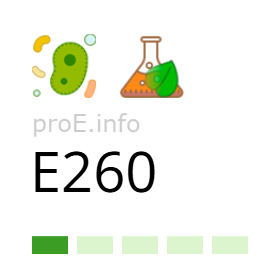
Other names for the additive (synonyms)
General Information
The food additive E260, more commonly known as acetic acid or vinegar, is used in the food industry as an acidity regulator. It is mainly applied in aqueous solutions at concentrations of 3–9% (vinegar) and 70–80% (vinegar essence).
Additive E260 has a characteristic pungent smell. In aqueous solutions, acidity regulator E260 is a relatively weak acid. In its pure form, acetic acid is a colorless, corrosive liquid that absorbs moisture from the environment and freezes at 16.5 °C, forming solid colorless crystals. The chemical formula of acetic acid is C2H4O2.
Vinegar has been known for thousands of years as a natural product of beer or wine fermentation. In 1847, German chemist Hermann Kolbe first synthesized acetic acid in a laboratory. Today, only about 10% of the global production of acetic acid is obtained through natural methods.
However, the natural fermentation method remains important, as many countries have regulations requiring that only biologically derived acetic acid be used in the food industry.
In the biochemical production of additive E260, certain bacteria’s ability to oxidize ethanol (alcohol) is used. This method is known as acetic fermentation. Raw materials for producing additive E260 include fermented juices, wine, or aqueous alcohol solutions.
There are also several methods of synthesizing acetic acid industrially. The most common method, responsible for more than half of global production, is carbonylation of methanol in the presence of catalysts. The initial components for this reaction are methanol (CH3OH) and carbon monoxide (CO).
Effects on the Body
Benefits of additive E260
Acetic acid plays an important role in the human body. Its derivatives help break down carbohydrates and fats that come with food.
Acetic acid is produced by certain types of bacteria, particularly Clostridium acetobutylicum and species of the Acetobacter genus. These bacteria are commonly found in water, soil, and food, and enter the human body naturally.
Risks of additive E260
The toxic effects of additive E260 on the human body depend on the dilution level of acetic acid with water. Solutions with acetic acid concentrations above 30% are considered hazardous to health and life. Highly concentrated acetic acid can cause severe chemical burns when it comes into contact with skin or mucous membranes.
According to the assessment by EFSA, long-term studies show that acetic acid is neither carcinogenic nor genotoxic. The JECFA committee has not set a limit for the acceptable daily intake (ADI) of acetic acid.
Uses
In the food industry, additive E260 is used in baking confectionery products, preserving vegetables, producing mayonnaise, and other food items.
Acetic acid is also used:
- in household applications (descaling kettles, surface cleaning);
- in the chemical industry (as a solvent and reagent);
- in medicine (for the production of pharmaceutical products);
- in other industrial sectors.
Legal Status
Acidity regulator E260 is approved for use in food products in all countries as a food additive considered safe for human health.
In the European Union, E260 is included in the list of permitted additives according to Regulation (EC) No 1333/2008. In the United States, acetic acid is recognized as safe (GRAS) by the FDA.